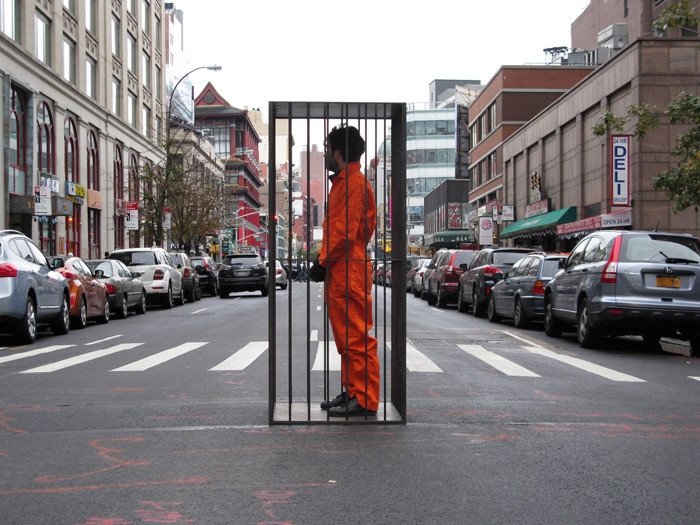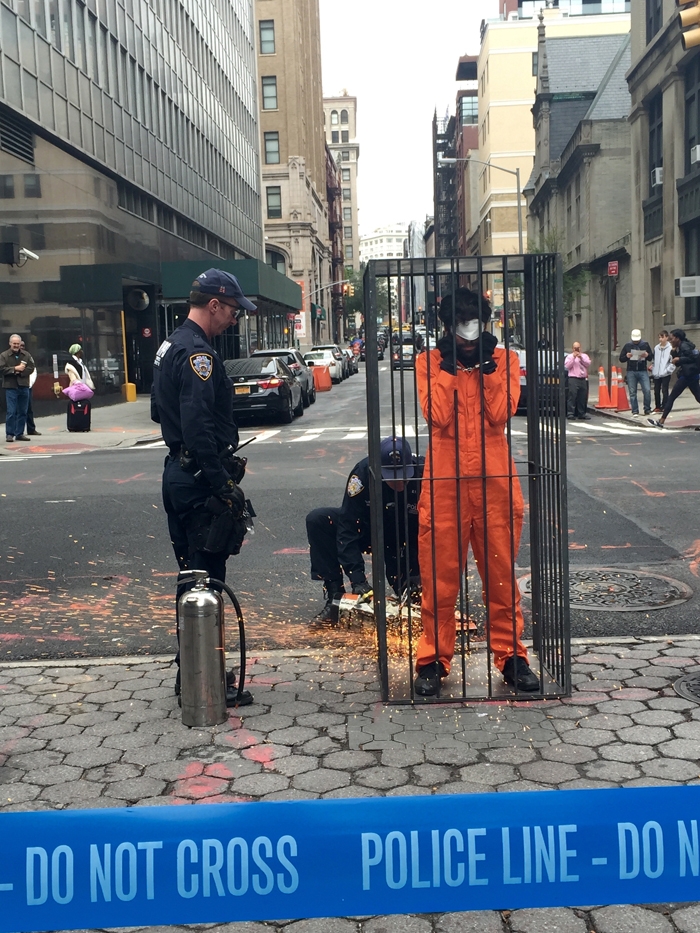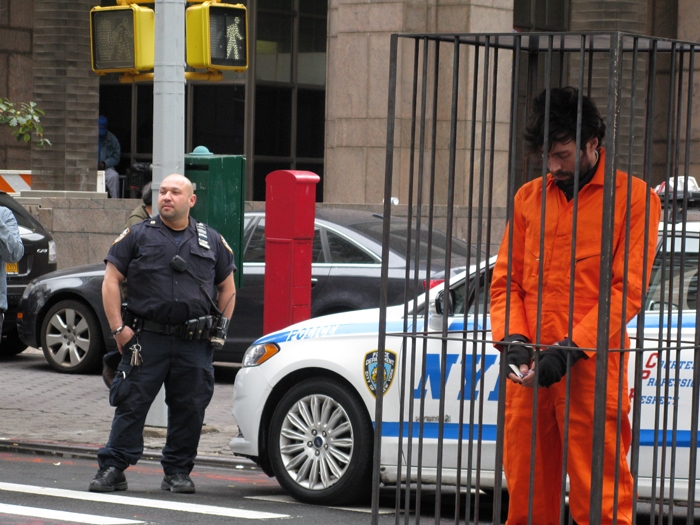NEW YORK – On October 25, a sealed cage was unloaded into the middle of a busy Lower Manhattan intersection. Inside of it was a man wearing what was by all appearances standard prison uniform: an orange jumpsuit on his body and steel cuffs on his hands. As the unmarked van which carried him pulled away, this prisoner was locked and left alone in the middle of the street.
Little did the passersby in front of the Manhattan Detention Complex know that what they were seeing was a piece of art action five years in the making.

The prisoner in the public eye was in fact Lech Szporer, the multidisciplinary artist and New Yorker whose piece marked the culmination of five years of planning (Hannes Charen)
The man behind the action was Lech Szporer, a multidisciplinary artist and New Yorker whose piece marked the culmination of five years of planning. Szporer designed his art project as a commentary on mass incarceration and a call for immediate and meaningful conversation on mismanagement of mental health, addiction, and nonviolent crime.
“Hello my name is Lech Szporer. This is an art performance. Nothing against you but the system needs to change. I’m not talking without my attorney.”
— The card held by the silent Szporer during his performance.
The action sought to raise the questions, and did. Are we compassionate? Do we see the humanity of the incarcerated? Do we work to fix problems or only to push them out of sight?
Descended from Polish grandparents who had spent time in both Nazi concentration camps and Soviet Gulags, Szporer offers his own unique view to 21st century America’s problem of mass incarceration. When combined with his vision as an artist, the well-executed action has used the image of one man locked in a cage in a public place to draw attention to all those locked up outside of the public eye.
The action ended when police sawed the artist out of his completely sealed cage, and he was loaded into an NYPD van for processing on charges of Obstructing Government Administration, a misdemeanor which carries a potential year in prison. Szporer’s charges were, however, later reduced to two counts Disorderly Conduct, a minor violation.
Szporer’s hope is that the attention from the crowd which had gathered around the action, from the media, and academics will not just work to augment the growing national discussion on prison reform, but help to change its vector. We spoke with the artist, who doesn’t particularly find hope in the current Sentencing Reform and Corrections Act.
“I think it’s a step in the right direction yes and I am glad that there’s a bipartisan bill on the table to somewhat ease our ‘get tough on crime’ policies – but in reality the Sentencing Reform and Corrections Act is only a small step forward while we have a monumental challenge ahead of us in regards to reducing incarceration rates and helping people reintegrate into society,” he said of a recent bill proposed in the Senate. “It’s estimated that this bill, if put into law, will only reduce the prison population by 5%-7% in the next 10 years. That’s not good enough.”
Szporer is instead a strong supporter of the Cut 50 movement, which aims to safely reduce the nation’s incarcerated population by 50% in the next decade.
Though the action itself only lasted for a few hours, its effective execution can be traced to the years of preparation. We spoke with Szporer who said the demonstration was in fact the culmination of five years of planning and ten years of inspiration, and shared this behind the scenes video.
Szporer had a dedicated team of twelve working on the project for the past five years, carefully planning for legal, logistical, and impact concerns.
Throughout the planning and action phases, the artist had a progressive criminal defense attorney behind him planning and offering support for any conflict which might arise.
What seemed to be a potential cause for conflict, the interactions between Szporer and the police which descended upon the scene within minutes to force the cage open, was averted.
“I am happy to say that the police this time respected that I was not attacking them as individuals but the system at large,” said the artist in an interview.
In fact, the law enforcement response served to enhance the power of the action – in order to complete his statement against mass incarceration, Szporer had to be released from behind bars by the police who are often seen as representatives of that system. In this way the project’s resolution offered a preview of its larger goal.

After being removed from the street, Lech Szporer is released by police from his sealed steel cage (Julia Lourie)
On the question of the need for more than piecemeal or superficial change, Szporer gives the following analysis:
For the past 40 years we’ve been given this rhetoric of prison reform and yet we’ve seen incarceration rates quadruple, conditions in prison get worse, and systemic racism continues. We have to be very wary of prison reforms and make sure that these reforms are moving in the right direction of eventually dismantling the prison system as is and moving toward a smarter and more effective way of addressing communities affected by crime – or are these reforms used to quell popular concerns and/or expand prison expenditures. What we need to focus on is expanding human rights not prison expenditures.
I also think we need to address the historical, systemic, and structural effects of racism in regards to our criminal justice system. Slavery was systemic racial violence. Enough was enough and Americans launched the Abolitionist movement. But then there was a backlash with Jim Crow laws, legal segregation, lynchings, and widespread discrimination. This was a regurgitation of systemic racial violence. And again, enough was enough, and Americans launched the Civil Rights movement and this was a fantastic moment in our history. But then what happened? Another backlash with the Prison Boom.
It’s no secret the prison boom was a political response to the gains brought about by the Civil Rights era and it’s in the past 40 years that we’ve seen the mass disenfranchisement of black voters, the spending-cuts in education, child-care services, mental health care services and and an astronomical increase in spending on prisons and peculiar deals with private corrections companies. The Bush/Reagan era of deindustrialization and deunionization and the War on Drugs and Get Tough On Crime polices were primarily directed toward poor communities of color and much of the media of this period helped to stigmatize black lives and criminalize minor offenses in an attempt to create a new “other” (the criminal) to attack. And the problem as I see it is that the prison system today comes from the Jim Crow and Slavery ethics of yesterday, and sadly, once again, we see that we have to stand up once again against this new form of systemic racial violence, and continue the Abolitionist movement of yesterday.
Why is it that today 1 out of 3 black males have been to prison or can expect to end up there? Why is it that there are more black males in prison than were enslaved at the height of slavery? Why is it that so many unarmed black youths are killed by police officers throughout a year? These are symptoms of a wider problem of racism on both a social and institutional level.
Another of the artist’s strategies is the sustained focus to the larger goal of mass decarceration. Later this year, Szporer and his associates are leading an exhibit and panel discussion on postcriminality at Manhattan’s Y Gallery.
The exhibit, Burial for the Rebellion: Studies in PostCriminality, deals with a series of actions and artworks addressing art, criminality, and their relationship. It runs from the 16th to 31st of December.
The panel, on December 18th, features, in addition to Szporer himself:
- Chino Hardin, Field Trainer and Community Organizer at Center for NU Leadership.
- Joseph Jazz Hayden, a community organizer with All Things Harlem who led the campaign to end Stop and Frisk.
- Susan Tipograph, a private criminal defense attorney for 40 years and former representative of the National Lawyers Guild’s New York Branch.
- Charles Vincent Sabba, an artist and active-duty NJ police officer.
Burial for the Rebellion: Studies in PostCriminality runs from December 18th through 31st at the Y Gallery.

